#april 2018 inter-korean summit
Link
The agreement was made during high-level talks on the northern side of Panmunjom that separates the two Koreas. They, however, did not unveil the date of the meeting.
"We agreed to hold an inter-Korean summit within September in Pyongyang" the two Koreas said in a joint press statement issued after the meeting.
North Korea's chief delegate, Ri Son-gwon, hinted after the meeting that the two sides agreed on a date but decided not to announce it, only to emphasize that the summit will take place "within September."
The summit meeting, if held, will mark the third of its kind between South Korean President Moon Jae-in and North Korean leader Kim Jong-un following their face-to-face meetings in April and May. It will also mark the first time in more than a decade for an inter-Korean summit to be held in the North's capital, with the last one held in 2007.
In the April summit, the two leaders agreed to meet again in Pyongyang this fall.
During Monday's talks, the two Koreas also discussed what has been implemented since their previous summits, especially on their promised efforts to expand cross-border exchanges and cooperation.
They have been at odds with the speed and scope of inter-Korean exchanges, though there have been a flurry of talks on details on cooperation in various areas, including railways, roads and sports.
The North has voiced frustration with the slower-than-expected pace in progress on those fronts. The Seoul government appears reluctant to push for full-blown cooperation with the North, constrained by multilayered sanctions imposed on Pyongyang.
Another possible agenda item for the high-level talks is to declare a formal end to the 1950-53 Korean War, which their leaders agreed to complete by the end of this year.
135 notes
·
View notes
Link
In a bid to keep Washington’s ongoing denuclearization talks with North Korea from faltering, U.S. Defense Secretary Jim Mattis said Wednesday that a major joint military exercise with South Korea would be scaled back.
“We have taken a decision,” Mattis said, according to a transcript of his conversation with reporters. “We are not canceling exercises. We are realigning one exercise.”
Asked if it was the Foal Eagle exercise, a large-scale drill typically held in the spring, Mattis confirmed this was the case.
“Foal Eagle is being reorganized a bit to keep it at a level that will not be harmful to diplomacy,” he said.
Mattis did not provide details on what a scaled back version of the exercise would look like.
“The United States and the Republic of Korea (ROK) conduct regular, routine training and exercises to enhance our ability to defend the ROK and maintain our combined military readiness,” Pentagon spokesman Lt. Col. Christopher Logan told The Japan Times on Thursday, adding that Mattis and South Korean Defense Minister Jeong Kyeong-doo had earlier agreed that military activities, including exercises, should be “conducted in a manner that complements diplomatic efforts to achieve North Korea’s denuclearization while sustaining the readiness” of the two countries’ military forces.
“The secretary and minister agreed to continue the close review of all large-scale combined military exercises, and to make coordinated decisions based on the advice of our military commanders,” Logan said. “We continue to look at multiple aspects of future exercises to include their size and scope.”.
The U.S. and South Korea have canceled their last four scheduled large-scale joint exercises on the Korean Peninsula as part of an attempt to give diplomats more breathing room in the negotiations with Pyongyang. North Korea has long viewed the exercises with skepticism, blasting them as a rehearsal for invasion. The U.S. and South Korea say are defensive in nature.
On Thursday, North Korean’s state-run media criticized Seoul for continuing its own military exercises after a spate of meetings and agreements between the two countries’ leaders.
“The South Korean military claims that the war drills ‘have nothing to do with inter-Korean agreements’ and ‘are of defensive nature,'” the official Korean Central News Agency said. “Its claim is nothing but a pretext to cover up its sinister intention for confrontation.
“Dialogue and military confrontation, peace and war drills can never go hand in hand,” it added.
The Foal Eagle exercise has in recent years included about 11,500 U.S. troops and 290,000 South Korean troops, and has consisted of field drills involving ground, air, naval and special operations forces. It has also typically been held together with a computer-simulated exercise known as Key Resolve, which last year included about 12,200 Americans and 10,000 South Korean personnel.
U.S. President Donald Trump, just after his landmark June summit with North Korean leader Kim Jong Un, unexpectedly announced that he would order a halt to large-scale exercises — a move that caught even the Pentagon by surprise.
The U.S. leader has repeatedly characterized the exercises as “war games,” calling them both “provocative” and “expensive.”
Mattis has worked to reassure Pentagon staff and U.S. officials concerned about the degradation of the combat readiness of the 28,500 U.S. service members in South Korea if the exercises continue to be canceled.
It is unclear if any move to downgrade the exercises will help kick-start nuclear negotiations with North Korea.
Talks have been largely stalled since Trump and Kim agreed at their historic Singapore summit in June to work toward the “complete denuclearization of the Korean Peninsula.”
U.S. Secretary of State Mike Pompeo has held out hope of a second Kim-Trump meeting early next year.
Pompeo had been scheduled to meet with Kim Yong Chol, Kim’s right-hand man, in New York earlier this month to begin laying the groundwork for the second summit, but that meeting was abruptly postponed a day before it was supposed to take place.
Two Koreas to Connect DMZ Road Thursday
South and North Korea will connect a road within the Demilitarized Zone(DMZ) on Thursday as part of an inter-Korean military agreement aimed at easing border tensions.
It is the first time for a road to be connected within the DMZ since the Korean Armistice Agreement was signed in 1953.
A military official in Seoul said on Thursday that the two sides will connect the unpaved road at Arrowhead Ridge in Cheorwon, Gangwon Province.
Under the military deal signed in September, the Koreas have removed landmines and explosives in the area and sought to connect the road to facilitate the planned joint excavation of Korean War remains.
The joint excavation will take place from April through October next year.
10 notes
·
View notes
Link
The inter-Korean summit kicked off with South Korean President Moon Jae-in and North Korean leader Kim Jong-un meeting at the Military Demarcation Line in Panmunjeom at 9:30 a.m.
The two leaders attended a welcome ceremony and began their meeting at the South's Peace House at about 10:15 a.m. After the meeting, Moon and Kim finally announced that they will work together for "complete denuclearization of the Korean Peninsula".
Below is the full joint statement by North and South Korean leaders, released by the South Korean presidential office on Friday (Unofficial Translation).
<Panmunjeom Declaration for Peace, Prosperity and Unification of the Korean Peninsula>
During this momentous period of historical transformation on the Korean Peninsula, reflecting the enduring aspiration of the Korean people for peace, prosperity and unification, President Moon Jae-in of the Republic of Korea and Chairman Kim Jong Un of the State Affairs Commission of the Democratic People's Republic of Korea held an Inter-Korean Summit Meeting at the 'Peace House' at Panmunjeom on April 27, 2018.
The two leaders solemnly declared before the 80 million Korean people and the whole world that there will be no more war on the Korean Peninsula and thus a new era of peace has begun.
The two leaders, sharing the firm commitment to bring a swift end to the Cold War relic of longstanding division and confrontation, to boldly approach a new era of national reconciliation, peace and prosperity, and to improve and cultivate inter-Korean relations in a more active manner, declared at this historic site of Panmunjeom as follows :
1. South and North Korea will reconnect the blood relations of the people and bring forward the future of co-prosperity and unification led by Koreans by facilitating comprehensive and groundbreaking advancement in inter-Korean relations. Improving and cultivating inter-Korean relations is the prevalent desire of the whole nation and the urgent calling of the times that cannot be held back any further.
① South and North Korea affirmed the principle of determining the destiny of the Korean nation on their own accord and agreed to bring forth the watershed moment for the improvement of inter-Korean relations by fully implementing all existing agreements and declarations adopted between the two sides thus far.
② South and North Korea agreed ...
Read more: http://www.ohmynews.com/NWS_Web/View/at_pg.aspx?CNTN_CD=A0002429064
326 notes
·
View notes
Photo

18th October >> (@zenitenglish) #PopeFrancis #Pope Francis Receives President of Republic of Korea.
Pope Francis Receives President of Republic of Korea
Appreciation for Efforts to Reduce Tension on Korean Peninsula
(Jim Fair @ZenitEnglish)
Pope Francis on October 18, 2018, received Moon Jae-in, President of the Republic of Korea, who subsequently met with His Eminence Cardinal Secretary of State Pietro Parolin, and with Archbishop Paul Richard Gallagher, Secretary for Relations with States.
During what the Vatican termed “cordial discussions”, the parties evoked the good bilateral relations and the positive contribution offered by the Church in the social, education and healthcare sectors, as well as the promotion of dialogue and reconciliation between Koreans. Strong appreciation was expressed for the common commitment to fostering all useful initiatives to overcome the tensions that still exist in the Korean Peninsula, in order to usher in a new season of peace and development.
Finally, some matters of a regional nature were discussed.
The audience with the Holy Father follows closely on a Mass celebrated the evening of October 17, 2018, by Cardinal Parolin in St. Peter’s Basilica. The Mass included prayers for peace on the Korean peninsula.
President Moon, who is Catholic, his wife, and a group of Korean faithful, priests, and missionaries attended the Mass, along with many members of the Holy See’s diplomatic corps, according to Vatican News.
In his homily, Cardinal Parolin said that they were praying for peace in the world, especially in the Korean Peninsula, so that “after so many years of tension and division, the word peace may finally fully resound…peace is built by daily choices, by a serious commitment to the service of justice and solidarity, by the promotion of the rights and dignity of the human person, and especially by caring for the weakest…But, for the one who believes, peace, first of all, is a gift that comes from above, from God Himself.
“With God’s grace the path of forgiveness becomes possible, the choice of fraternity among peoples becomes a concrete fact, peace becomes a shared horizon even in the diversity of those who make up the international community.”
Pope Francis spoke about the “historic” summit on Friday, April 27, 2018, between North Korean leader Kim Jong-un and his southern counterpart, Moon Jae-in, on the dividing military dividing line. the peninsula, to Panmunjon. Kim Jong-un was the first North Korean leader to walk on South Korean soil since the Korean War (1950-1953).
“I accompany with prayer the positive outcome of last Friday’s Inter-Korean Summit and the courageous commitment of the leaders of both sides to a sincere dialogue for a Korean Peninsula free of nuclear weapons,” said the Pope. Francis after the Marian prayer of Regina Caeli, Sunday, April 29, St. Peter’s Square, in the presence of some 30,000 pilgrims.
“I pray to the Lord that hope for a future of peace and fraternal friendship will not be disappointed and for the collaboration to continue to bear fruit for the beloved Korean people and the whole world, “added the pope who had repeatedly invited Catholics to join his prayer for the success of this dialogue, including April 25, at the Wednesday audience.
The Vatican also welcomed the denuclearization agreement last June: “In Singapore, go with history,” headlined L’Osservatore Romano dated June 13, 2018, making its front page on the agreement between the president American Donald Trump and North Korean leader Kim Jong-un, on the denuclearization of North Korea.
The summit, which took place on June 12, 2018, in Singapore, saw “the long-awaited handshake, which lasted more than ten seconds, with Trump who strengthened the contact by also briefly placing his left hand on the arm Kim’s right, “noted the Vatican daily.
The previous Sunday, the pope had invited the crowd – of some 20,000 pilgrims – to present at the Angelus of June 10, 2018, St. Peter’s Square, and all those who followed the Angelus live, to pray with him a ” Hail Mary “for this purpose.
Full Text of Cardinal Parolin’s Homily
OCTOBER 18, 2018 18:27
POLITICS
1 note
·
View note
Text
July 27, 2018: Take Me to North Korea
안녕하세요,
Before I left Los Angeles, my mom and the International Studies advisor both reminded me to not do anything stupid and visit North Korea.
With that said, this is a blog on when I visited the North-South Korean border.
I have been planning to visit the Demilitarized Zone (DMZ) ever since I chose South Korea as the country I wanted to study in. North Korea had been the hot topic of discussion recently because of Donald Trump and Kim Jong Un's heated exchange of words via Twitter and the recent Winter Olympics in Pyeongchang, South Korea when the two Koreas marched under one flag.
On April 27, the Inter-Korean Summit happened where both Kim Jong Un and Moon Jae In crossed the border - Kim Jong Un stepped into South Korea and Moon Jae In stepped into North Korea.
On June 12 was the first US-North Korea Summit in Singapore when Donald Trump and Kim Jong Un finally met and talked about denuclearization of North Korea.
So, yes. North Korea had been under the spotlight throughout the year, and when's the best time to visit the border than being in South Korea?
I chose to visit the DMZ on July 27, the 65th anniversary of when both Koreas signed the Korean Armistice Agreement in Panmunjom to cease armed forces, putting an unofficial end to the Korean war.
I was supposed to go with Florence, Wendelyn, and Esther, but everybody woke up late. Florence woke up a good half hour before the start of our trip under Seoul City Tour; Wendelyn and Esther did not wake up at all, despite of our never-ending attempts of messaging and calling them.
I waited outside Itaewon Station Exit 1, the exit that both Wendelyn and Florence both told me to write. The van picked me up and waited for five minutes until Florence arrived. We drove for about ten minutes before transferring to a bigger tour bus at 8:30 AM.
We drove by the Imjin River where the tour guide showed us why the edges of the streets were fenced by telling us the story of the Blue House Raid or the January 21 Incident in 1968.
1960s South Korea was just a big mess. The Vietnam War was ongoing where both the US and South Korea were sending troops to support South Vietnam, then-North Korean leader Kim Il Sung was finding ways to reunify the Korean peninsula under his rule, and then-South Korean president Park Chung Hee seized power after the 1961 coup-d'état forcing the democratically-elected Yun Bo Seon out of office, ending the Second Republic's parliamentary system giving rise to a military government under Park Chung Hee.
Now, Kim Il Sung hand-picked 31 soldiers - the best North Korea could offer - with one goal in mind: kill Park Chung Hee. Since the United States was preoccupied sending military troops to support South Vietnam during the war, it was in Kim Il Sung's best interest to take over South Korea at this time and reunify the peninsula under his leadership.
Kim Il Sung said that by killing President Park, it will cause political chaos in South Korea and North Korea would go in to aid and provide support to their "South Korean brethren".
Well, the 31 hand-picked North Korean soldiers, called Unit 124, successfully crossed the North-South Korean border and swam across the Imjik River into Seoul. They were close to getting into the Blue House, but we all know they did not successfully kill Park Chung Hee and reunite the peninsula under Kim Il Sung, right? Please read more about the Blue House Raid because it's very interesting.

We reached the city of Paju, just south of Panmunjom, and parked at Imjingak, a park where the Bridge of Freedom lies. There was an old train on the track which was used by the North Koreans who were repatriating into South Korea during and after the Korean War. The area surrounding the bridge and the train were covered by the South Korean and reunification flags wishing for a united Korea one day, so the separated families can reunite once again. There also stood Mangbaeddan, an altar where Koreans can go and pay their respects and honors to their families who stayed in North Korea after the war.
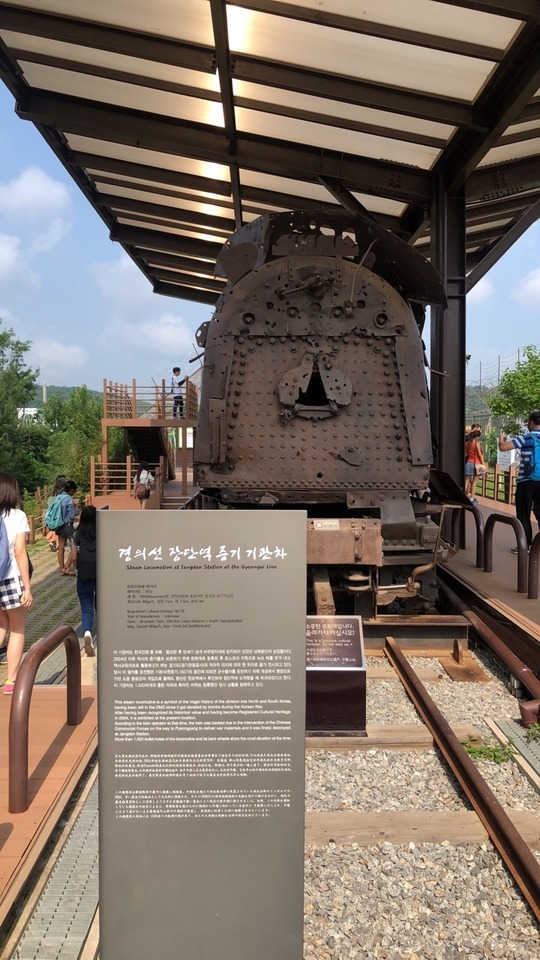
After Imjingak, we drove to the Third Infiltration Tunnel. It is one of the four known tunnels dug up by North Korea to infiltrate into South Korea for a surprise attack on Seoul. There is said to be up to twenty tunnels running from North Korea to South Korea, though only four have been discovered. The tunnels can accommodate up to 30,000 armed men every hour, and all four discovered tunnels lead up to the capital city of Seoul.
Upon discovery of the third tunnel, North Korea denied the allegations and said it was part of a coal mine even though the tunnels are granite, which is igneous in origin (coals would be found in stones of sedimentary in origin). The tunnel was also found to have been sprayed with black paint to make it look like coal.
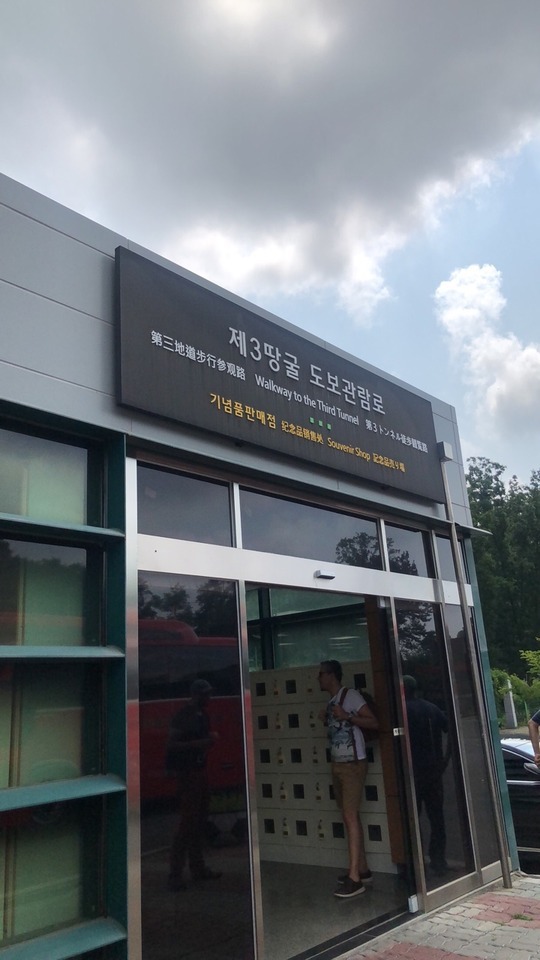
We were required to leave our belongings in the lockers and had to go through security to make sure no electronics were brought in. We had to climb down a 350-steep slope to get to the tunnel that crosses the North-South Korean border with helmets on. Upon reaching the third tunnel, the ceilings were wet with water and could only accommodate people who were within five feet tall - compared to South Koreans, North Koreans are noticeably shorter due to malnourishment. We walked until we reached the end to peak at the North Korean end of the tunnel, which was inaccessible to visitors, then we had to climb back up the same 350 meter-steep tunnel.
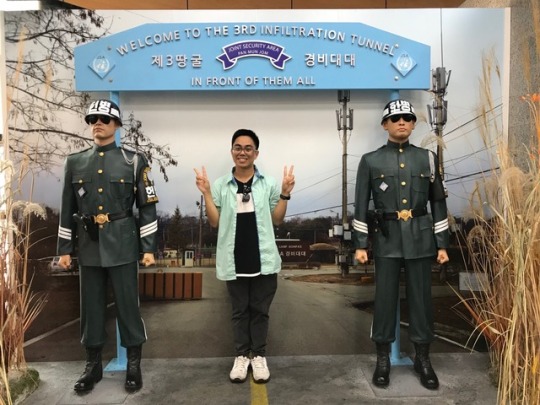
After the tunnel, went across the park to watch a movie on the Korean War, the Korean Armistice Agreement, the discovery of the four tunnels, and the booming country of South Korea. The topic of reunification to reunite the separated families and for a peaceful peninsula echoed throughout the film.

After the film, Florence and I took pictures with the DMZ sign and a reunification statue that depicted an Earth split in two with the Korean peninsula on both half. Men, women, and children are pushing the halves to make Earth whole once again.

After the visit to the tunnel, we drove up the Dorasan Observatory, which is the closest point of South Korea to North Korea. In the observatory, the visitors could see Kijong-dong, the North Korean Propaganda Village. The village was established in the 1950s, showcasing North Korea as rich and well-established, as an attempt to lure North Korean defectors and South Koreans to go to the North. South Korea built a flagpole on its side of the demarcation line, and North Korea retaliated by building a taller one next to the Propaganda Village.
The Flagpole War started where both countries decided to beat each other for the tallest flagpole, where South Korea finally decided to end it and have North Korea win. For over a decade, the North Korean flagpole was the tallest in the world, until Azerbaijan established a taller flagpole in National Flag Square in 2010.
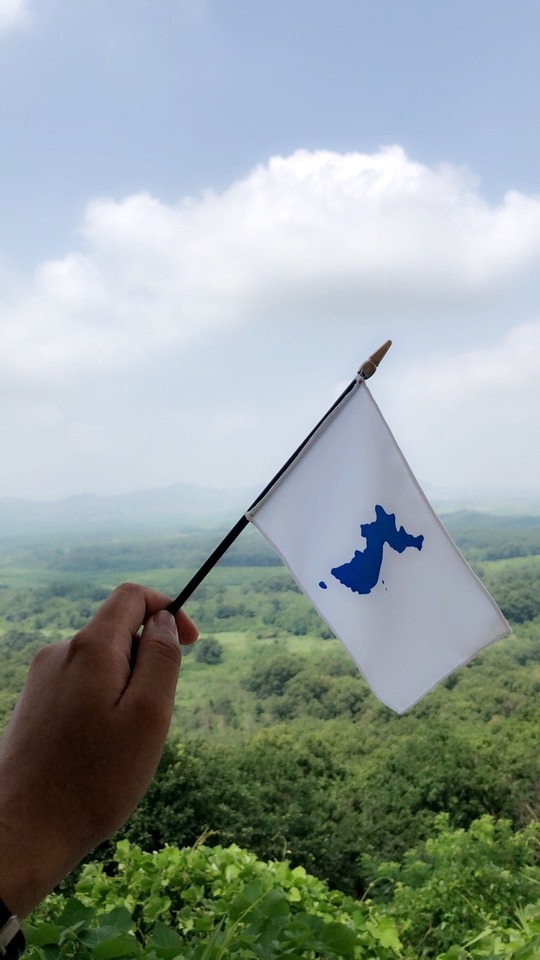
From Dorasan Observatory, the visitors can also take a glimpse of the Kim Il Sung statue and can also take pictures with South Korean soldiers patrolling the area.
We bumped into Esther, who's touring in a different time schedule with us. Wendelyn was taking the late afternoon tour after waking up later than Esther.
We, then, headed to Dorasan Station, a train station established in 2002 by Korail that would start working once the peninsula is reunited.
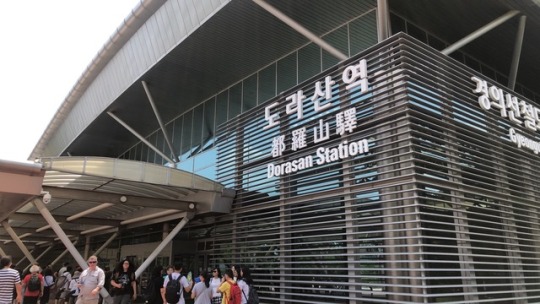
Dorasan Station has a line that would lead to Pyeongyang, although the main purpose of the station right now is to instill hope for a future reunification. The station is very reminiscent of Incheon International Airport and Seoul Station, equipped with information desks, waiting area (much similar to Seoul Station), a marquee that showed the train schedule, and an entrance to the train that would make a trip to Pyeongyang.
We bought commemorative train tickets to Pyeongyang before heading out.
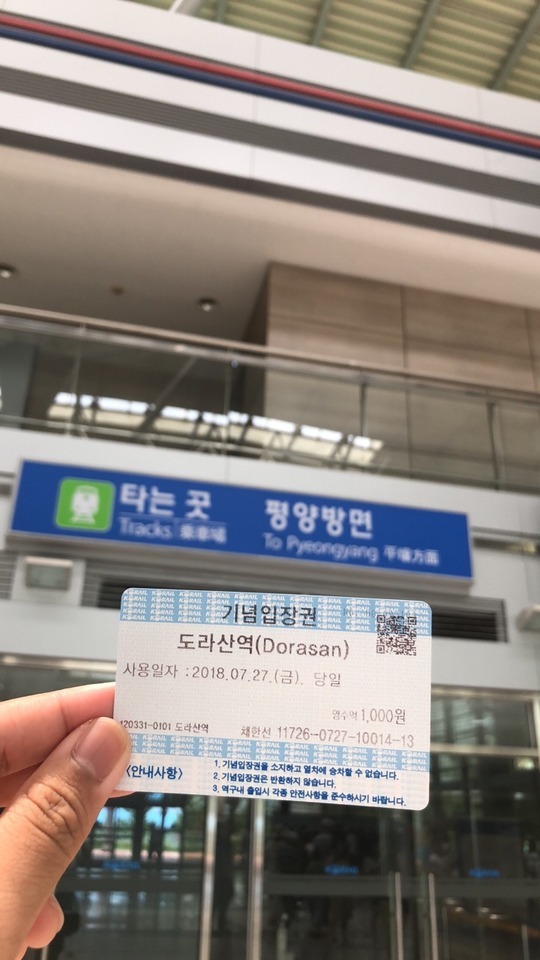
After the trip to Dorasan Station, we stopped by a ginseng place where an Indonesian woman talked to us about the benefits of ginseng and lead us to a room that sold different forms of ginseng, which brought terrible flashbacks of my time in Beijing with the fake tour Simi and I ended up with.
We were dropped off at City Hall right after, close to Gyeongbokgung and Namdaemun Market, where Florence and I walked around under the 110-degree weather.
We wanted to wait for Sophie, who was at Namsan Tower, to eat with her at Chanyeol's Viva Polo, but she wasn't able to, so both Florence and I settled for naengmyeon at Yukssam Naengmyeon (육싼 냉면) at Namdaemun, before heading back to Anam around 3 PM.
It was an educational day, although I was sad I did not get to meet with Sophie one last time since my train ride to Busan was later that night. Maybe I will see her next time, maybe when I book a trip to Vienna, Austria? Until then!
고마워요,
Chris 「크리스」
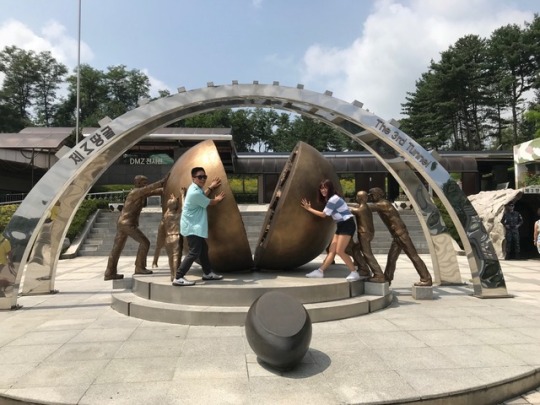
P.S. I woke up craving bulgogi and kimchi today. I really miss Seoul. We would still role-play on the Kakao group chat about meeting in front of Frontier for a meal - Matt would ask to borrow my shaving cream, and we would pretend to plan on picking Valentino and Peter up from their rooms.
#abroad#international summer campus#isc#ku#study#summer#korea university#seoul#korea#north korea#dmz
3 notes
·
View notes
Photo

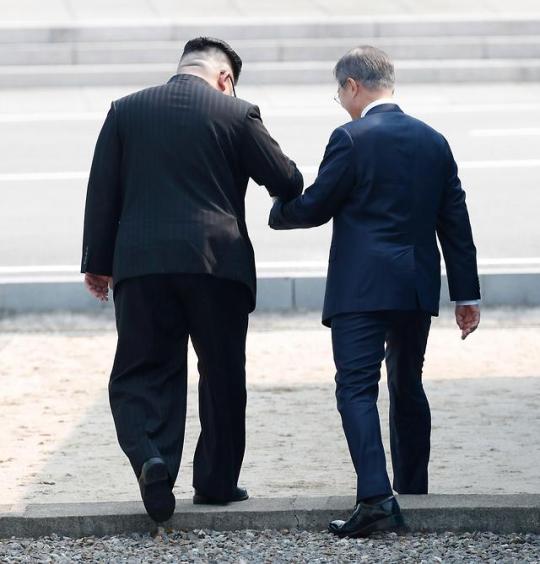
South Korean President Moon Jae-in (R) and North Korean leader Kim Jong-un (L) hold hands as they cross the military demarcation line (MDL) at the Joint Security Area (JSA) on the Demilitarized Zone (DMZ) in the border village of Panmunjom in Paju, South Korea, 27 April 2018. South Korean President Moon Jae-in and North Korean leader Kim Jong-un are meeting at the Peace House in Panmunjom for an inter-Korean summit. The event marks the first time a North Korean leader has crossed the border into South Korea sine the end of hostilities during the Korean War. (Photo by EPA)
11 notes
·
View notes
Text
Here Are The Shows Canceled This Week Due To 2018 Inter-Korean Summit
Here Are The Shows Canceled This Week Due To 2018 Inter-Korean Summit
With the 2018 inter-Korean summit taking place on April 27 between President Moon Jae In of South Korea and Kim Jong Un of North Korea, there will be some changes coming up to the regular television schedule over the next few days. The three major networks (MBC, KBS, and SBS) will focus on the 2018 inter-Korean summit this week, airing special broadcasts and newscasts instead of the regular…
View On WordPress
#Baek Jong Won&039;s Alley Restaurant#I Live Alone#It&039;s Dangerous Beyond the Blankets#Law of the Jungle#Radio Star
6 notes
·
View notes
Link
The liaison office was launched in the North's border town of Kaesong, with around 50 people each from the two Koreas attending the opening ceremony.
The move is a follow-up on an agreement that the leaders of the two Koreas reached in their April summit to run such an office on hopes that the office will serve as a communication channel to help facilitate inter-Korean cooperation on various fronts.
"The inter-Korean joint liaison office is a channel for round-the-clock communication in the new era of peace," South Korea's Unification Minister Cho Myoung-gyon said in a congratulatory speech.
"From today, South and North Korea can have direct consultations 24 hours a day and 365 days a year over issues relating to advances in inter-Korean relations, peace and prosperity on the Korean Peninsula," he added.
The opening ceremony was attended by South Korean officials and others from the parliament and academia. Among the North Koreans who joined the event is Ri Son-kwon, who has led high-level inter-Korean talks for months, according to the ministry.
Ri expressed hope that the office will help the two Koreas improve their relations and serve as a stimulus to peace and prosperity on the peninsula.
"With the opening of the office, both sides are able to discuss any issues arising in their relations in a speedy and heart-to-heart manner and figure out necessary countermeasures," he said in a speech.
12 notes
·
View notes
Link
South and North Korea launched their joint liaison office on Friday, securing a platform for round-the-clock communication that is expected to help foster cross-border exchange and ease tensions.
The liaison office was launched in the North's border town of Kaesong, with around 50 people each from the two Koreas attending the opening ceremony.
The move is a follow-up on an agreement that the leaders of the two Koreas reached in their April summit to run such an office on hopes that the office will serve as a communication channel to help facilitate inter-Korean cooperation on various fronts.
"The inter-Korean joint liaison office is a channel for round-the-clock communication in the new era of peace," South Korea's Unification Minister Cho Myoung-gyon said in a congratulatory speech.
"From today, South and North Korea can have direct consultations 24 hours a day and 365 days a year over issues relating to advances in inter-Korean relations, peace and prosperity on the Korean Peninsula," he added.
South Korea will station around 20 officials there, while the North will deploy 15-20 officials to the office.
Vice Unification Minister Chun Hae-sung will serve as a co-head for the office along with Jon Chong-su, a vice chairman of the Committee for the Peaceful Reunification of the Country, a North Korean agency in charge of inter-Korean exchanges.
The co-heads will meet every week.
The opening ceremony was attended by South Korean officials and others from the parliament and academia. Among the North Koreans who joined the event is Ri Son-kwon, who has led high-level inter-Korean talks for months, according to the ministry.
Some businesspeople who used to run companies in a now-shuttered industrial park in Kaesong were invited to the opening ceremony. The Seoul government said that their joining has nothing to do with efforts to resume the operation of the park.
Launched in 2004, the industrial park was hailed as a key symbol of economic cooperation between the Koreas as it combined South Korean capital and technology with cheap labor from the North.
South Korea, however, shut it down in 2016 in response to the North's nuclear and missile tests. Washington has been apparently opposed to the resumption of its operation as it could run counter to sanctions imposed against North Korea.
It was the first time that people who used to run companies in the industrial complex had visited Kaesong since its closure.
6 notes
·
View notes
Photo
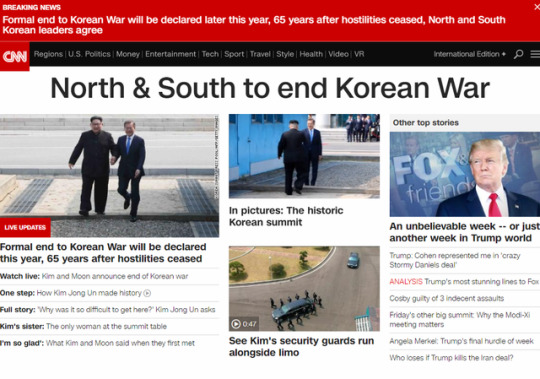
2018 Inter-Korean Summit War is over April 27 2018
4 notes
·
View notes
Photo

25th April >> (@zenitenglish) Pope Francis Appeals for ‘Concrete Journey of Reconciliation’& ‘Transparent Dialogue’ at Inter-Korean Summit Assured his “personal prayer” and “the closeness of the whole Church” to the Korean people “who long for peace” (Deborah Castellano Lubov @zenitenglish) For the upcoming Inter-Korean Summit, Pope Francis has appealed for a ‘concrete journey of reconciliation’and ‘transparent dialogue.’ The Holy Father did so during his General Audience this morning in St. Peter’s Square. The Summit is scheduled for April 27, 2018 in Panmunjon, with the leaders of South and North Korea, Moon Jae-in and Kim Jong-un. This meeting, the Pope said, “will be a good opportunity to launch a transparent dialogue and a concrete journey of reconciliation and renewed brotherhood, in order to guarantee peace in the Korean Peninsula and in the whole world.” The Holy Father expressed his “personal prayer” and “the closeness of the whole Church” to the Korean people “who long for peace”. The Holy See, he expressed, “accompanies, supports and encourages every useful and sincere initiative to build a better future, the emblem of the encounter and friendship between peoples”. “To those who have direct political responsibilities, I ask you to have the courage of hope, by making yourselves artisans of peace.” He also urged them to “pursue confidently the path undertaken for the good of all.” APRIL 25, 2018 11:22POPE AND HOLY SEE
3 notes
·
View notes
Link
June 7, 2018: Since the historic April 27 summit between the leaders of North and South Korea at Panmunjom, longstanding tensions and war threats on the Korean peninsula have given way to the promise of peace and reconciliation. Soon, another historic summit, between the United States and North Korea, will take place in Singapore. The two parties, which not too long ago were on the brink of war, will finally sit down to discuss a peaceful settlement to the Korean War. All eyes of the world will be on this momentous event, which could determine not only the fate of the Korean peninsula and Northeast Asia but also the prospect of global peace.
We—Korean Americans who have long fought for peace and the self-determined unification of the Korean peninsula, and allies who stand on the side of peace and justice and share a critical stake in the struggle for peace in Korea—wish to make clear our views on the recent inter-Korean summit and the upcoming U.S.-North Korea summit.
Read more
#HandsOffKorea#Korean American#antiwar#summit#North Korea#South Korea#imperialism#Donald Trump#Korean War#peace treaty
3 notes
·
View notes
Text
North Korea’s Secret Christians
By Rachel Cohrs, The Atlantic, April 28, 2018
SEOUL--South Korea turned off dozens of high-volume loudspeakers on Monday, putting a halt to the propaganda they normally broadcast over the border into North Korea. The move, a government spokesman said, was designed to set a peaceful tone ahead of the talks between the two Koreas Friday--a tone that was reinforced by the announcement that the countries had committed to work toward a peace agreement. The strikingly amicable inter-Korean summit will in turn set the tone for an upcoming U.S.-North Korea summit, during which President Trump and Kim Jong Un are expected to discuss denuclearization of the Korean Peninsula. But while the South’s loudspeakers have stopped blaring reports critical of the North, forbidden messages are still flowing across the border--on the airwaves of a Christian radio station.
South Korea’s largest religious radio broadcaster, the Far East Broadcasting Company, transmits gospel-centered programs to both North and South Korea every day of the week. The station’s goal is to use Christian radio to subvert the Kim regime’s strict ban on religion, and ultimately pave the way for a unified, Christianized Korean Peninsula. The Christians behind FEBC advocate for the reunification of the two Koreas under a democratic system, which they believe would bolster religious freedom. What’s more, they see Christianity and North Korean ideology as mutually exclusive--and argue that the former can be an antidote to the latter.
Around 20 percent of South Korea’s population identifies as Protestant, and Protestantism has roots on the Korean Peninsula stretching back to the 19th century, when American missionaries began arriving there. The religion gained stature as churches became associated with the resistance to Japanese occupation of a then-unified Korea during World War II, but still remained on the margins--only 2 percent of South Koreans were Christian in 1945.
But the two Koreas took different religious paths following their division in 1948. In South Korea the government was friendly toward the United States and Christianity, and Protestantism continued to grow based in part on its association with wealth, modernity, and Americans. Churches also served as social hubs for rural South Koreans who moved to cities during the country’s industrialization. But under the communist system that took root in the North, religion was suppressed, though not altogether outlawed. The current Kim regime is intolerant of any independent religious practice.
FEBC spreads its message through far-reaching broadcasts--the station has a strong 300-kilowatt transmitter that can reach all of North and South Korea, as well as Japan and parts of Russia and China. Beyond broadcasting, the station also hosts Christian music festivals and runs children’s choirs that travel internationally. It receives approximately 1.2 million calls, texts, and letters per year from listeners and is entirely funded through donations. Though it’s impossible to estimate North Korean listenership, Mary Kay Park, a media strategist at the station’s Los Angeles branch, estimated that the number is likely “in the thousands.”
The station broadcasts different programs to its North Korean audience than to its South Korean listeners. North Korean programming focuses on defector-run shows about Christianity and provides audio church services--the latter because most North Koreans cannot attend local churches, or even speak about Christianity, without risking forced labor or execution. While the North Korean government allows a few formal, state-controlled religious groups, the CIA World Factbook reports that these groups “exist to provide an illusion of religious freedom,” and that independent religious activity is “almost nonexistent” in the country. North Korea “curtails all basic human rights,” according to Human Rights Watch, and religious freedom is no exception.
In the 1940s, estimates put the number of churchgoing Christians in the North Korean capital of Pyongyang between 25 and 30 percent of all adult residents. Though it’s impossible to get an accurate count given the Kim regime’s strict controls on information, after decades of oppression, the United Nations in 2014 cited estimates that the number of Christians living in North Korea was then between 200,000 and 400,000, or around 1 percent of the country’s population.
But South Korean Christian groups like FEBC cannot meet them, or potential converts, face to face. Tourist visits to North Korea are closely chaperoned by state-employed guides, and proselytizing is prohibited. The station has settled for what it sees as the next best thing: reaching the curious through illicit radio receivers.
FEBC buys handheld radio receivers and gives them to Christian organizations that work with smugglers to get the radios into North Korea so residents can secretly listen to the station’s broadcasts. Chung Soo Kim, who has for more than 20 years been a radio host for FEBC, where he translates California pastor Rick Warren’s sermons, estimated that the company has purchased “tens of thousands” of receivers over more than two decades. He said he recognized that while simply owning a radio is not necessarily risky, smuggling the radios into North Korea, or being caught listening to FEBC, can be dangerous. FEBC sometimes donates receivers to organizations that send them over the border by balloon, rather than using smugglers on foot. (Secular human-rights organizations run similar smuggling operations to expose North Koreans to foreign movies and television.)
Because the radios are not pre-set to any specific channel, recipients of the radios can choose which stations they want to listen to. Chung Soo Kim said FEBC does not encourage North Koreans who listen to its programming to share their faith with others under the current regime. “We just want to share the Christian gospel with them. We don’t want them to put themselves at risk by openly claiming that they are Christian in North Korea.” He added that although the North Korean government has attempted to jam its signals, “financially, they cannot afford to jam our broadcasts. They do not even have enough food to feed their own people.”
The station has indications from defectors’ testimonies and listener feedback that its broadcasts are reaching their destination. Sookook Kim, who works in the feedback department, said correspondence from North Korean listeners is rare because of the risk involved in sending it, but arrives occasionally. She recounted one letter from a Christian living in North Korea who listened to the company’s broadcasts under a blanket at 4 a.m., the only time that listener deemed it safe to do so. The listener meticulously copied down pages of sermons and Bible passages and sent the papers to the station with a monetary offering. “It was so touching for us,” she said. “If we don’t receive these kinds of materials, it’s hard to have faith that they are really listening to FEBC Korea.”
1 note
·
View note